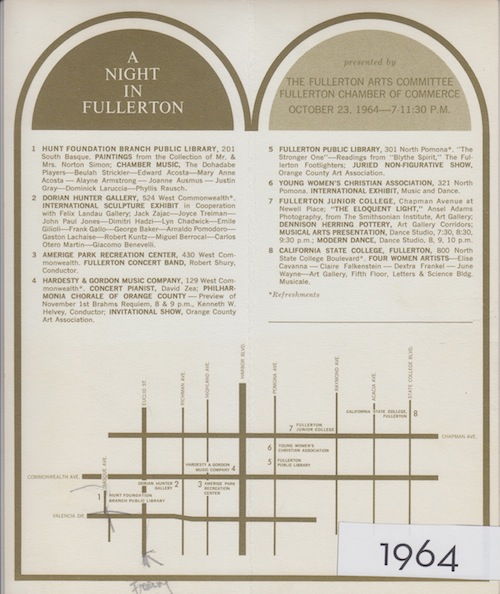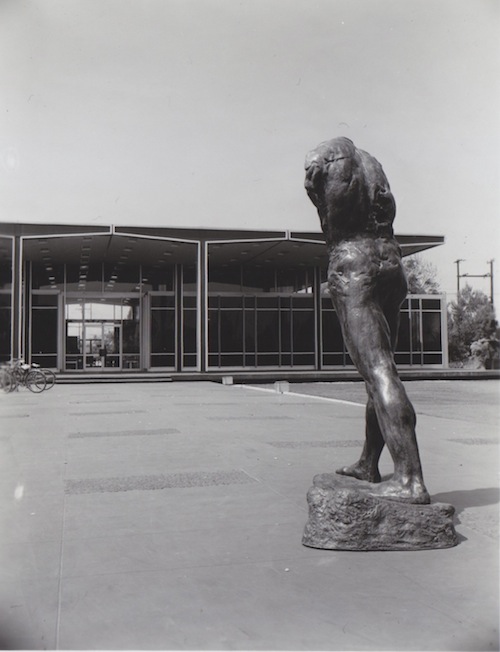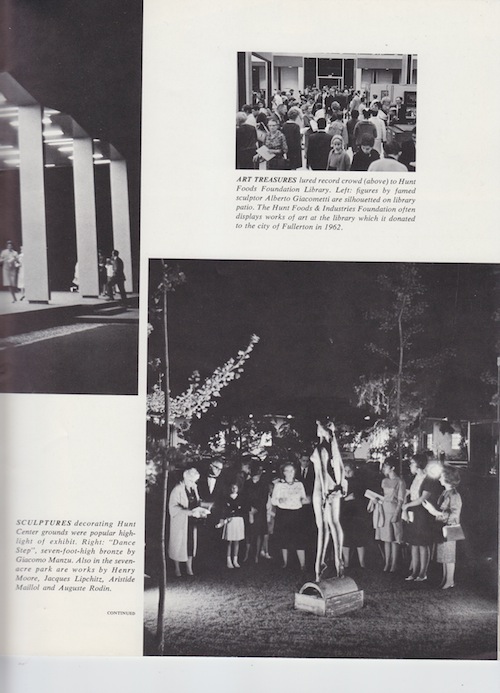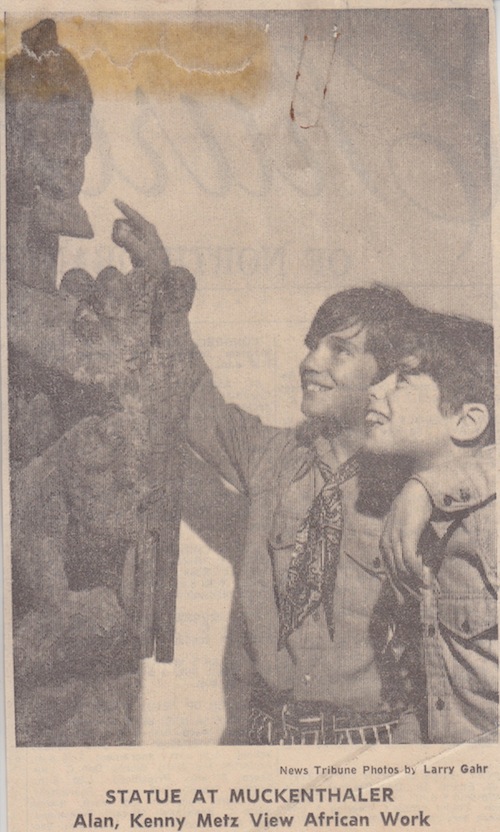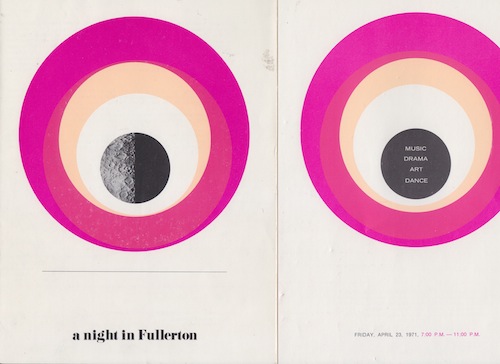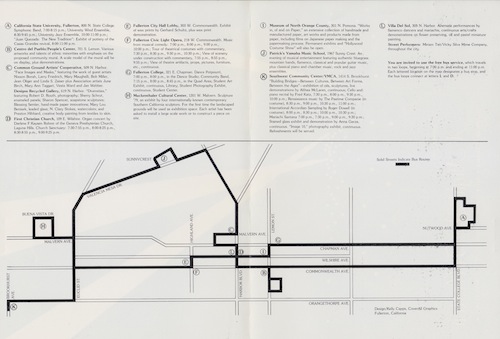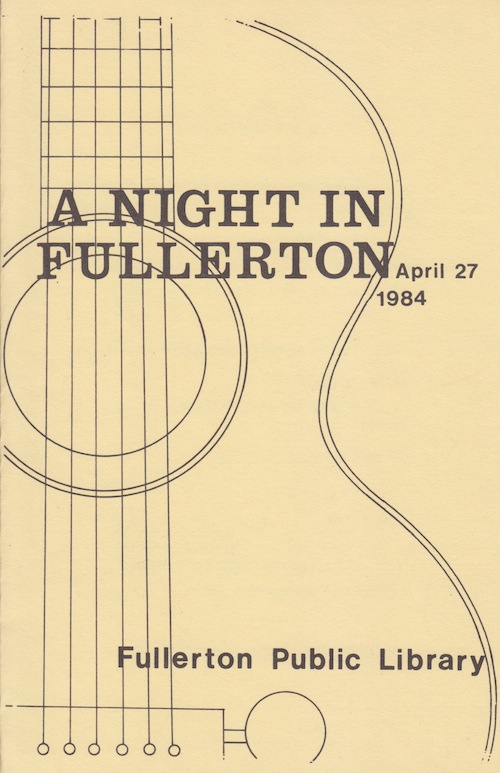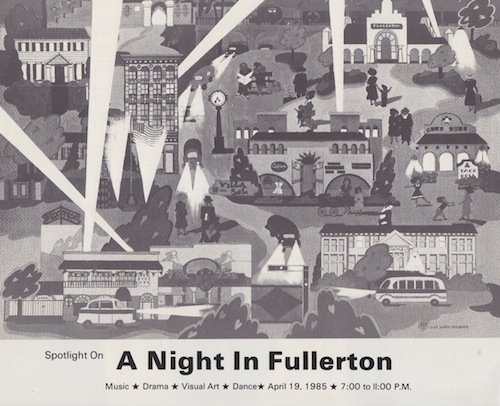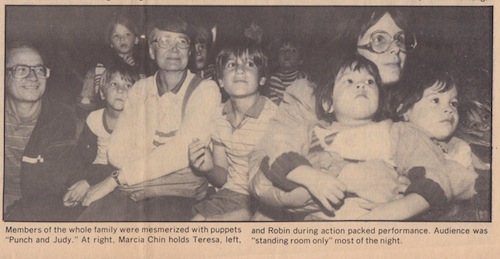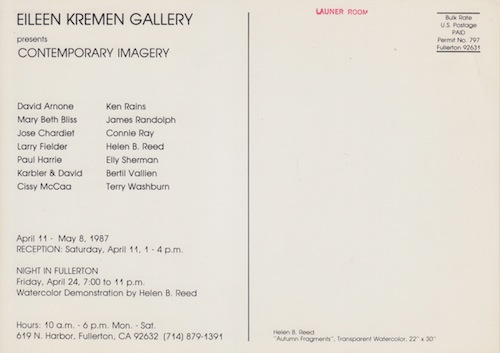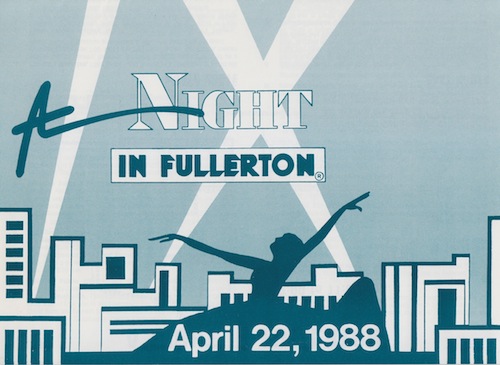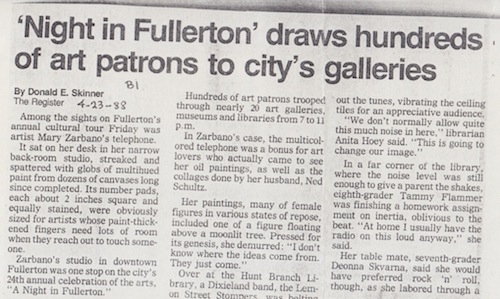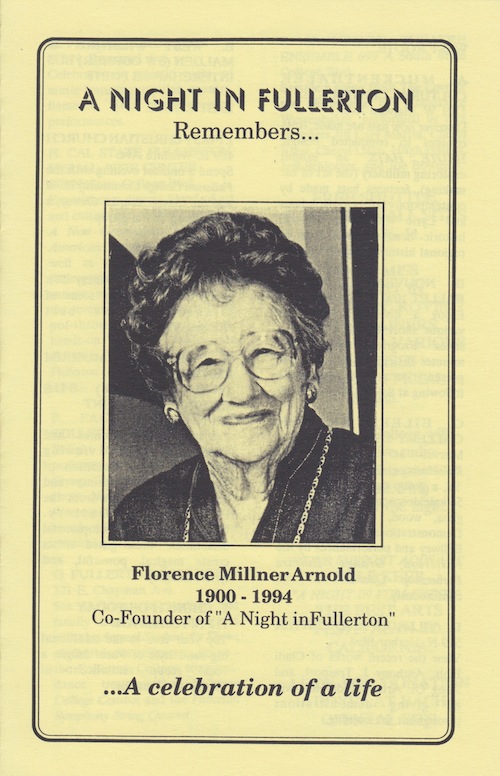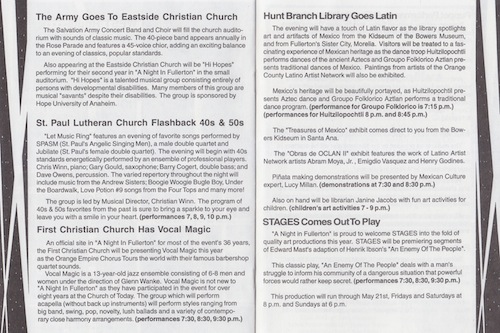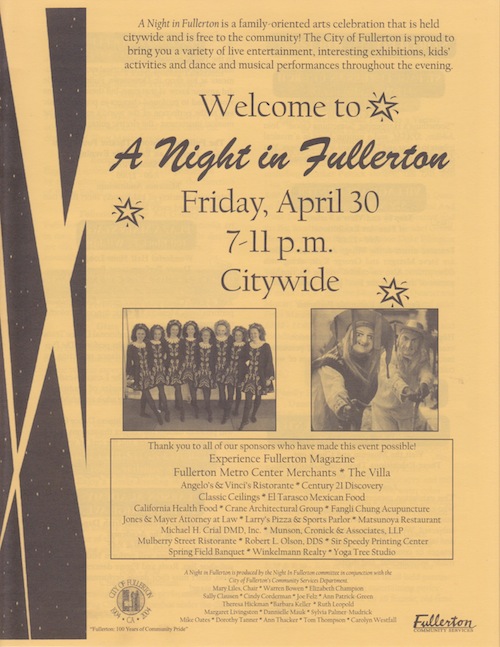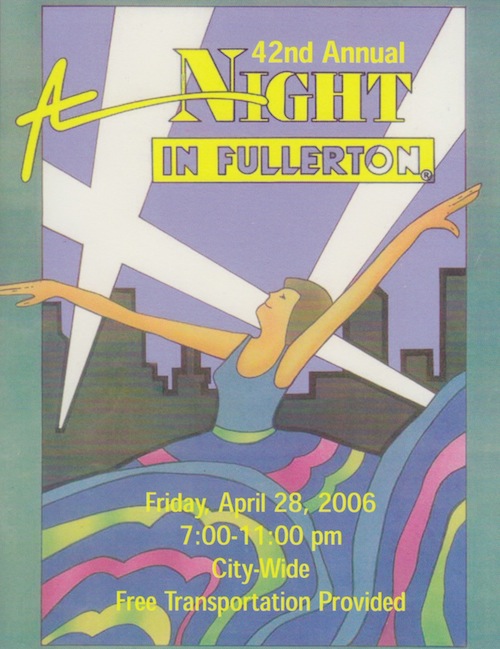Before there was the Downtown Fullerton Art Walk, there was "A Night in Fullerton." This was an annual city-wide cultural celebration featuring art, music, drama, and dance. For 45 years, the city of Fullerton hosted this event. Free shuttles would take people from Cal State Fullerton to Downtown to the Hunt Branch Library on a night of creative expression and community.
"A Night in Fullerton" lasted from 1964-2009. In an effort to better understand this important part of my city's cultural history, I've been hanging out in the Local History Room of the Fullerton Public Library, scanning documents. I've also had the pleasure to befriend two of the original organizers of this event, Dorian Hunter (who owned a gallery in Fullerton from 1963-1969) and Marjorie Kerr, a local artist who has twice shown at my Fullerton gallery, Hibbleton. And so, for all who are interested, here is my history of "A Night in Fullerton."
 |
| Florence Arnold, Co-Founder of "A Night in Fullerton" |
"A Night in Fullerton" was conceived in 1964, when local artist Florence Arnold wanted to create a cultural event to show Norton Simon (who lived in Fullerton) that we were an art community. Norton Simon was a well-known collector of fine art, and he had offered to gift the city a world-class art museum. He built the Hunt Branch Library as a proposed site. Florence enlisted the help of local gallery owner Dorian Hunter and a group of artists to create the event. "A Night in Fullerton" debuted in 1964, and Norton Simon's collection was on display at the Hunt Branch for all to see. The event was an extraordinary coordination of art venues in a historically conservative town. The first "A Night in Fullerton" included eight venues, listed below. Fullerton (Junior) College had Ansel Adams photographs on display.
And, at the Hunt Branch Library, there were paintings by Picasso, Cezanne, Goya, Degas, and other masters.
Sculptures by Rodin, Giacometti, and other masters graced the grounds.
"A Night in Fullerton" was off to a great start!
The next year, 1965, was also a success. William Pereira was the architect who designed the Hunt Branch Library. Mr. Pereira also designed the Transamerica Pyramid in San Francisco, the Geisel Library at UC San Diego, the Disneyland Hotel, and the master plan for the City of Irvine. He displayed his drawings at Fullerton College.
By this point, Dorian Hunter's gallery was in full swing, Cal State Fullerton was hosting art exhibits and plays, and it seemed that Fullerton was becoming a legitimate arts destination. By 1966, the number of venues had grown to nine.
Notice the artists on display at the Hunt Branch: Titian, Matisse, Picasso. No big deal.
Norton Simon was still in negotiations with the city about making the Hunt Branch a permanent art museum. And then, for some reason, the Fullerton City Council decided it couldn't pay for security guards. And thus begins one of the greatest mysteries (and tragedies) of Fullerton's history. The city's leaders fucked up the museum offer, and it didn't happen.
Nonetheless, "A Night in Fullerton" continued. 1967 appears to have been a particularly active and exciting year. The library file is filled with articles, flyers, and photos from that year.
 |
| Dorian Hunter is on the left. |
The Villa del Sol Plaza at Harbor and Wilshire hosted the Danzas Folkloricas Mexicanas.
The Fullerton Public Library displayed paintings by Hans Burkhardt.
The 1968 flyers had cool graphic design. 1968 was a crazy year in America. It was the year Martin Luther King Jr. and Bobby Kennedy were assassinated. The Anti-War movement was in full swing, and the country was filled with social changes and challenges.
The Hunt Branch continued to display Norton Simon's artwork...
But things were not going well with city council...
Meanwhile, Dorian Hunter continued to host radical art shows...
1969 was another year of awesome graphic design.
Dorian Hunter had a psychadellic light show at her gallery.
The Mukenthaler Cultural Center had African sculptures...
But, alas, 1969 was also the last year Norton Simon displayed his art at The Hunt Branch Library. He'd taken the hint, and took his collection elsewhere, to Pasadena, where The Norton Simon Museum would open in the early 1970s.
In 1970, there was no "A Night in Fullerton." No reason was given in the library archives, only this letter...
...and a single newspaper clipping, about a man named Frank "Marty" Reid who worked for the Chamber of Commerce. The article doesn't mention how he was related to "A Night in Fullerton" or if he had something to do with it being cancelled in 1970. 1969 was also the last year of the Dorian Hunter Gallery. What happened in 1970? It was a year of loss for the Fullerton art community. Dorian continued to be involved in organizing "A Night in Fullerton."
But all was not lost. In 1971, "A Night in Fullerton" continued...
In 1972, this was the flyer. The early 1970s had some awesome graphic designs.
On back of the 1972 flyer, there was a quote by Florence Arnold. It seems to acknowledge the losses of the past couple years, but also it shows hope for the future. Her initial goal of bringing the Norton Simon Museum to Fullerton had faded, but there was still a local art scene.
Cool 1973 poster...
Notice that, on this list of venues, the Hunt Branch Library has gone from being the top billing, to being at the bottom of the list. By this time, Norton Simon had given up on Fullerton, and was in negotiations with Pasadena, where his museum would ultimately be located.
In 1974, Cal State Fullerton was a very important part of "A Night in Fullerton." Among their various exhibits was one of Native American photographs by one of the unsung art heroes of the 20th century, Edward S. Curtis. Also, a new gallery appeared in Fullerton, Fine Print Gallery.
Rad 1975 poster...
In 1975, Dorian Hunter began to show work at her Interior Design office on Chapman Avenue, which she called The Design Block. Dorian doesn't quit.
That year, Dorian hosted an outdoor slide presentation of the environmental arts...
1976 was the Bicentennial of the United States of America.
That year, there were 14 participating venues...
That year, Dorian Hunter hosted a film festival.
Cal State Fullerton hosted a large, interactive inflatable art exhibition.
In 1976, the organizers also drafted a list of "Purposes" and "Guidelines" of "A Night in Fullerton." The purposes are very similar to those of The Downtown Fullerton Art Walk.
1976 also saw the birth of a new artists' cooperative called Common Ground. It was located across the street from the Fox Thteatre on Harbor. Local artist Marjorie Kerr designed the graphic on the side. This building (which is now a State Farm Insurance agency) is one of the few examples of art deco architecture in Fullerton. It is a little local treasure, built in 1946.
The rainbow design theme continued in 1977.
I like the 1978 flyer.
Here are the participating venues/map from 1978:
In 1978 there was also a really cool sculpture exhibit at the Fullerton Public Library, featuring work by Aldo Cassanova, who did the large "Flight" scultpture outside the library, which is still there today.
1979 is the year I was born.
In 1980, Florence "Flossie" Arnold turned 80, and there was a big celebration. She was well-loved.
The Night in Fullerton flyers hit a bit of a graphic design lull from 1979-1984, where they all looked basically the same. I blame Ronald Reagan.
1983 saw the birth of yet another art gallery in Fullerton, called Edge Gallery.
In the file from 1983, I found these guidelines for police and fire "explorers" who accompanied everyone on the buses that took people from venue to venue. It sounds like it would be a pretty somber and un-fun activity to explore local culture accompanied by police officers and firemen. Not only that, but there were "rules" for these buses, which included "NO LOUD TALKING." I'm trying to imagine how lame it would be for attendees to ride quietly around in a bus with law enforcement, like prisoners or children. I think, in the 80s, A Night in Fullerton began to really decline.
Interestingly, in 1983, Florence Arnold was ill and unable to attend her beloved "A Night in Fullerton." In her stead, a fireman named Tom Thompson was in charge. That's probably why there were all those tight regulations.
However, the arts in Fullerton are resiliant, and (despite setbacks) there were still some legitimate galleries in downtown, like Common Ground, Designs Recycled, and Edge Gallery, not to mention the galleries at Fullerton College and Cal State Fullerton.
Both the Hunt Branch and the Fullerton Public Library remained important centers of local culture during "A Night in Fullerton."
Marjorie Kerr showed her work at the Hunt Branch.
While Martha Bartholomew, Mildred Kouzel, and others showed at the main branch library. Marjorie, Martha, and Mildred were part of an all-female artist collective called The Bloody Marys.
In 1985, there was a new design for the flyer!
Here's a flyer for an exhibit at Designs Recycled Gallery.
The public library continued to host cool exhibits, like this one.
In 1985, "A Night in Fullerton" got some local news coverage.
One of the iconic things about "A Night in Fullerton" was the skylights, shooting into the night sky at each venue. It must have been quite a sight to see, as this flyer from 1986 suggests.
1986 saw the birth of a few new galleries in downtown Fullerton: Gallery 57, Mary Zarbano Gallery, and Eileen Kremen Gallery.
The Fullerton Public Library had an amazing show of Native American arts and artifacts, and local scholar Paul Apodaca gave a talk. Paul has long advocated for appreciation of our local Native American tribes, like the Tongva and Acjachemen.
And someone named Margaret-Ann Ashton displayed her egg collection at the Hunt Branch Library.
In 1986, my family and I moved to Fullerton from Mt. Horeb, Wisconsin. That first year, I got mono nucleosis and was bed-ridden for four months. My first year in Fullerton kind of sucked. But things would get better.
1987 was the 100 year anniversary of the founding of Fullerton by George and Edward Amerige.
The Fullerton Observer ran this spread. I wonder of "A Night in Fullerton" was possibly in danger of going away.
Postcard from Eileen Kremen Gallery exhibit in 1987.
People on the Night in Fullerton committee got to wear these cool button badges.
1988 saw the introduction of Sarah Bain Gallery to "A Night in Fullerton." This gallery still exists today. It't now located in Brea.
1989 was the 25-year anniversary of "A Night in Fullerton." They used the original 1964 design.
1990 poster and map:
1991 poster and map:
Flossie got a special V.I.P. badge. She was 91 years old.
Beginning in the early 90s, the flyers started looking kind of cheap.
In 1992, Harbor Blvd. was closed down between Chapman and Commonwealth for "A Night in Fullerton."
There were no flyers at the library from 1993. In 1994, Florence Arnold passed away (age 94) and that year "A Night in Fullerton" was dedicated to her memory.
There are no flyers at the library for two years after Flossie's death, 1995 and 1996. I'm not sure if "A Night in Fullerton" happened those years. The next flyer is a cheesy try-fold from 1997, and things seemed to have changed. Costco is a major sponsor and, ironically, the flyer looks really cheap.
Looking over the venue list, all of the independent art galleries have disappeared. In their place, three churches appear on the list. What the hell happened?!
1998 was the year I graduated from Fullerton Union High School.
By 1999, "A Night in Fullerton" had been taken over by the City of Fullerton Department of Community Services, which made it subject to city budget approval. In 10 years, it would be finished.
Churches continued to play an important role which, from an artist's perspective, is pretty lame.
The flyer from 2000 is just bad, and the event seems to have lost it's original creative magic.
Church music? This doesn't sound like a fun event.
2001 "A Night in Fullerton Flyer." *facepalm
"Say, what are you doing tonight?"
"I'm going to 'A Night in Fullerton'."
"What's that?"
"It mostly involves going to local churches and listening to culturally irrelevant music."
"Sounds like a blast!"
Beginning in 2001, Cal State Fullerton stopped being a part of "A Night in Fullerton." At least there were puppets.
From 2003-2005, they hit another graphic design lull, lost their creativity, and used the same design template, as they had done in the early 80s. I blame George W. Bush.
"Do you enjoy brass band music?"
"No."
"Are you unable to make the whit Friday brass band contests in Saddleworth on June 13th?"
"What the fuck are you talking about?"
2004 flyer.
2005 flyer.
In 2006, there seems to have been a creative resurgence. There was decent newspaper coverage that year.
2007 flyer. C'mon people, stay creative!
In 2008, some friends and I opened Hibbleton Gallery in downtown Fullerton. That year, we were part of "A Night in Fullerton." At the time, I didn't think much of it. I thought, why not, it might bring more foot traffic. I had no idea of the rich history behind this event.
In 2008, the historic Fox Theater in Fullerton opened it's doors, to inform the public about its renovation efforts.
2009 was the last "A Night in Fullerton."
Just as galleries were once again starting to open their doors in 2009, the city "pulled the plug" on "A Night in Fullerton." But never fear, Fullertonians, something new was on the horizon.
In 2010, some gallery owners, artists, and business owners got together and organized the Downtown Fullerton Art Walk, which is an independently-run, multi-venue art event that happens the first Friday of every MONTH!
When I helped start the Art Walk, I had no idea of the history I was a part of. But now I do, and I have a deeper understanding of the challenges, joys, collaboration, and hard work it takes to keep the arts alive in my community.
This year, we celebrated our third anniversary. Here's hoping we last at least as long as "A Night in Fullerton" (45 years!)
The Downtown Fullerton Art Walk happens the first Friday of every month. Visit www.fullertonartwalk.com for more information!

